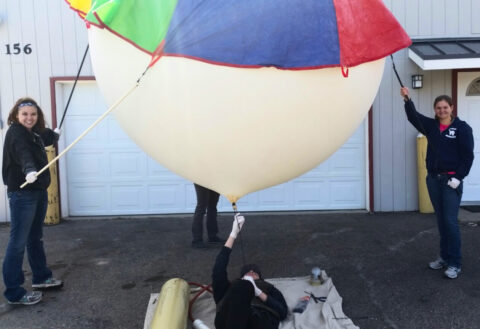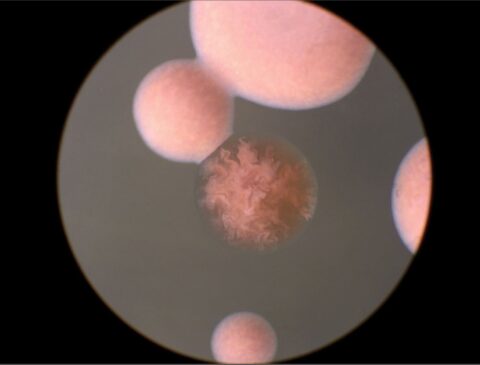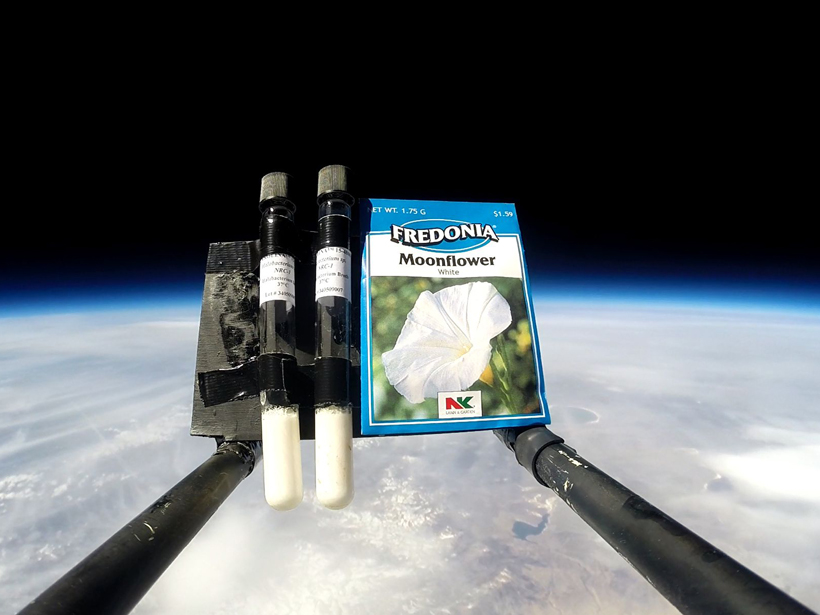Inflating a 2-meter-wide weather balloon is no easy task on a windy day, but these microbes were not going to launch themselves.
As the balloon filled with helium, the morning’s launch crew—a mix of high schoolers and recent graduates from California’s Bishop Union High School—secured a test tube full of microbes and a GPS to it. Together, they released the balloon and watched it float over the Sierra Nevada mountains.
The students—part of a club called Earth to Sky Calculus—are no strangers to launching weather balloons. They have conducted more than 75 such launches, with payloads equipped with instruments to measure temperatures, pressures, and radiation levels in the stratosphere.

This particular launch, one of three planned for the first weeks of April, had a more biological purpose—to send microbes to the upper reaches of Earth’s atmosphere. The goal: to see how high-stress environments affect the organisms, a finding that could help reveal how life on other planets might survive extreme conditions.
Sending Microbes Up High
The microbes in question, a salt-loving organism called haloarchaea, can survive extreme temperatures, air pressures, and radiation levels. Previous launches a few months back led the students to discover that the organisms could survive one trip into the stratosphere, but then the team came up with a batch of new questions: What would happen if the same test tube full of microbes journeyed to the stratosphere multiple times? How would the growth of those microbes compare to that of haloarchaea that never left Earth?
“I thought we could try to refine [the experiment] by getting growth curves and actually trying to produce data, not just saying ‘it grows’” after a trip into the upper atmosphere, said Carson Reid, an 11th grader at Bishop Union and leader of the current project.
The microbes face an atmospheric gauntlet while on their journey skyward and back.
The microbes face an atmospheric gauntlet while on their journey skyward and back. First, they pass through the boundary between the troposphere and stratosphere, where temperatures drop below −60°C. Higher up, the microbes enter the ozone layer, which exposes them to such high dose rates of cosmic rays—more than 40 times that found at sea level—that the microbes can mutate.
Air pressures are exceedingly low that high up, so the balloon explodes, sending its payload into a free fall at nearly 800 kilometers per hour until a parachute opens and slows its descent to Earth. Oftentimes, the cargo lands in Death Valley, just 80 kilometers away from the launch site, where surface temperatures can reach 50°C.
Using GPS signals emanating from the payload, the students and adult advisers track down the microbes and set out to collect them from wherever they land, be it in the middle of a Joshua tree forest, a day’s hike into the mountains, or on the side of a dusty highway.
Adventures in Microbiology
Although the students have become well versed in atmosphere physics and chemistry, analyzing archaea colonies in the laboratory is an entirely different beast.
That’s where the microbiologists come in.
Shil and Priya DasSarma’s lives revolve around haloarchaea. Their laboratory at the University of Maryland School of Medicine is dedicated not only to studying the organisms but also to partnering with outside groups, such as schools, for educational purposes. The students of Earth to Sky Calculus reached out to the DasSarmas last summer and formed an informal collaboration.
“Generally, when we’re studying these organisms in the lab, we’re subjecting them to a single stressor and seeing what the effect is in terms of survival,” said S. DasSarma. However, “ultimately, modeling something in the lab has limited value because what you really want to know is what happens in the real world,” he continued.

To see whether the extreme conditions—notably the high doses of cosmic radiation—caused any mutations, the students need to culture their archaea colonies and analyze them under a microscope.
Finding any mutated microbes will not be terribly difficult for the students, P. DasSarma said. Normally, haloarchaea are bright pink, but when mutated, they change color and have a distinctively odd look, like a glass marble or a foggy crystal ball.
After the students culture their archaea and identify potential mutants, the DasSarmas will come aboard for the more technical analysis of the survivors. This analysis includes tests to identify how the mutant archaea differ genetically from their counterparts, which S. DasSarma said could lead to discovering strains that are more resistant to radiation.
The Mars Connection
Haloarchaea are a model microbe for studying the type of life that could survive outside of Earth’s protective pocket of atmosphere, explained Tony Phillips, an astronomer who runs the website spaceweather.com. Phillips started the Earth to Sky Calculus club several years ago when his daughter and some of her classmates wanted to pursue more science and math projects outside of school, and he continues to serve as an adviser to the group.
“By sending these microbes 30 to 35 kilometers above our head, we’re sort of transporting them to Mars for a little while.”
“By sending these microbes 30 to 35 kilometers above our head, we’re sort of transporting them to Mars for a little while,” Phillips said.
High in the stratosphere, the conditions are much like those on Mars—where rovers are currently searching for signs of past or present life, Phillips said. Astrobiologists have long wondered what kinds of organisms could have lived—or might currently live—on the Red Planet. In fact, scientists have recently discovered seasonal flows on the planet that may be salty—the perfect environment for a salt-loving organism.
The microbes can also survive encapsulated within salt crystals, according to S. DasSarma. Considering that salt crystals have been found within meteorites from Mars, the students’ research could provide a preliminary look at whether microbial life could survive a trip across interplanetary space.
Students of Science
The first launch on 24 March went off without a hitch. The balloon, carrying a test tube full of haloarchaea, lingered in the atmosphere for almost 3 hours before exploding and sending its cargo hurtling toward Earth. On 1 April, graduate Amelia Yarborough, 11th grader Jamie Shultz, and 10th grader Jordan Herbst launched the second balloon, which carried two test tubes: one full of the microbes that had already visited the stratosphere and one with a fresh batch on its first flight.
The third and last launch is scheduled for 11 April but, depending on the weather, could be rescheduled. The last balloon will carry the test tubes from the previous two launches plus one more.
Reid, Yarborough, and Shultz were introduced to the group by friends, whereas Herbst joined after tagging along with his sister. They all stay because they love the learning environment and sharing their experiences with like-minded students. Although Yarborough graduated from Bishop Union last year, she still enjoys joining launches.
“Basically from the first day, I liked the new learning experiences and the comradery,” Yarborough said. “Spreading the knowledge is also a great feeling.”
—JoAnna Wendel, Staff Writer
Editor’s note: The title and text were changed to reflect that the microbes launched are archea, not bacteria.
Citation: Wendel, J. (2015), Can microbes survive multiple trips into the stratosphere?, Eos, 96, doi:10.1029/2015EO027827. Published on 9 April 2015.
Text © 2015. The authors. CC BY-NC 3.0
Except where otherwise noted, images are subject to copyright. Any reuse without express permission from the copyright owner is prohibited.

